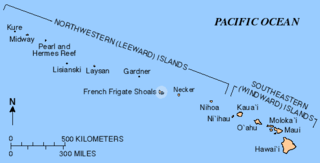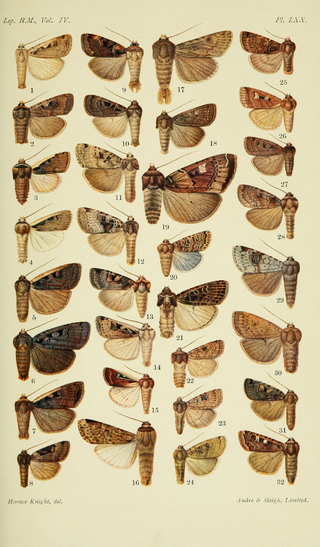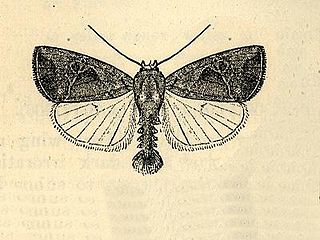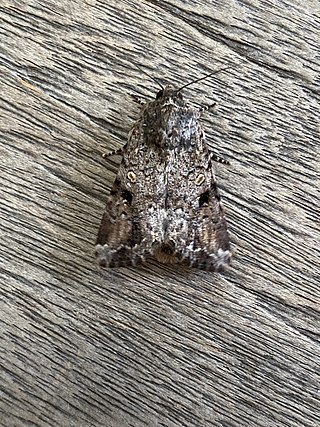
Kerr's noctuid moth is a species of moth in the family Noctuidae.

The Laysan noctuid moth is a species of moth in the family Noctuidae.
Elwood Curtin Zimmerman was an American entomologist best known for his two multivolume series: Insects of Hawaii published by the University of Hawaiʻi Press and Australian Weevils published by Australia's CSIRO.
Aumakua is a genus of moths of the family Noctuidae, consisting of one species Aumakua omaomao, which is endemic to Hawaii.
Agrotis ceramophaea is a moth of the family Noctuidae. It was first described by Edward Meyrick in 1899. It is endemic to the Hawaiian islands of Kauai and Hawaii.
Agrotis dislocata, the lesser native cutworm, is a moth of the family Noctuidae. It was first described by Francis Walker in 1856. It is endemic to the Hawaiian islands of Niihau, Kauai, Oahu, Molokai, Maui, Lanai, Hawaii and Laysan.
Heliothis melanoleuca is a species of moth of the family Noctuidae. It is endemic to Hawaii, where it is found in riparian forest.
Schrankia altivolans is a species of moth of the family Erebidae. It occurs in epigean habitats on Kauai, Oahu, Molokai, Lanai, Maui and Hawaii. It also occasionally occurs in caves on at least Maui and Hawaii.
Peridroma chersotoides is a moth of the family Noctuidae. It was first described by Arthur Gardiner Butler in 1881. It is endemic to the Hawaiian island of Maui. It has also been recorded from the islands of Molokai and Hawaii, but these references may be in error.

Peridroma cinctipennis is a moth of the family Noctuidae. It was first described by Arthur Gardiner Butler in 1881. It is endemic to the Hawaiian islands of Kauai, Oahu, Molokai, Maui and Hawaii.
Mythimna amblycasis is a moth of the family Noctuidae. It was first described by Edward Meyrick in 1899. It is endemic to the Hawaiian islands of Kauai, Oahu, Molokai, Maui, Lanai and Hawaii.
Mythimna macrosaris is a moth of the family Noctuidae. It was first described by Edward Meyrick in 1899. It is endemic to the Hawaiian islands of Kauai, Oahu, Molokai and Hawaii.
Acrapex mischus is a moth of the family Noctuidae. It was described by David Stephen Fletcher in 1959. It is endemic to the Hawaiian island of Oahu.

Elaphria nucicolora, the sugarcane midget, is a moth of the family Noctuidae. The species was first described by Achille Guenée in 1852. It is found from the south-eastern United States, through Guadeloupe, Jamaica and Puerto Rico to tropical South America. It is also present on the Hawaiian islands of Oahu, Maui and Hawaii.

Spodoptera mauritia, the lawn armyworm or paddy swarming caterpillar, is a moth of the family Noctuidae. The species was first described by Jean Baptiste Boisduval in 1833. Able to eat many types of food, it is a major pest throughout the world.
Amyna natalis, the ilima moth, is a moth of the family Noctuidae. It was first described by Francis Walker in 1858. It is widespread from tropical Asia into northern Australia. It is an introduced species in Hawaii, where it is found on Oahu.
Meganola brunellus is a moth of the family Nolidae. It is found in Sri Lanka, India, Taiwan, Japan, the Ryukyu Islands, Sundaland, Queensland and the Bismarck Islands. It is an introduced species in Hawaii.

The Erebinae are a subfamily of moths in the family Erebidae erected by William Elford Leach in 1815. Erebine moths are found on all continents except Antarctica, but reach their greatest diversity in the tropics. While the exact number of species belonging to the Erebinae is not known, the subfamily is estimated to include around 10,000 species. Some well-known Erebinae include underwing moths (Catocala) and witch moths (Thermesiini). Many of the species in the subfamily have medium to large wingspans, up to nearly 30 cm in the white witch moth, which has the widest wingspan of all Lepidoptera. Erebine caterpillars feed on a broad range of plants; many species feed on grasses and legumes, and a few are pests of castor bean, sugarcane, rice, as well as pistachios and blackberries.

Polydesma umbricola, the monkeypod moth or large tabby, is a species of moth in the family Erebidae. The species is found in southern Europe, Africa, Asia Minor to southern Asia, of India, Sri Lanka, Maldives, the Andaman Islands, including many Indian Ocean islands, like Coëtivy Island, Aldabra, Assumption Island, Madagascar and on Hawaii.






